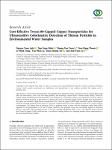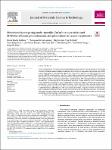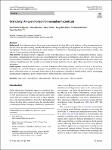Browsing by Subject Nanoparticles
Showing results [1 - 6] / 6
Thiram plays a critical role in protecting fruits and vegetables from damage by various crop diseases, but its residues significantly affect the environment, such as soil and water pollution, and becoming a serious threat to human health. Herein, Tween 80-capped copper nanoparticles (Tween 80-CuNPs) were developed as a convenient and low-cost colorimetric probe for selective detection of thiram pesticide. In the presence of thiram, the color of Tween 80-capped CuNPs changed from dark brown to olive green and colorless at high thiram concentrations. The Tween 80-capped CuNPs-based colorimetric probe exhibited good selectivity and high sensitivity (LOD about 0.17 μM) with a high lineari... |
Thiram plays a critical role in protecting fruits and vegetables from damage by various crop diseases, but its residues significantly affect the environment, such as soil and water pollution, and becoming a serious threat to human health. Herein, Tween 80-capped copper nanoparticles (Tween 80-CuNPs) were developed as a convenient and low-cost colorimetric probe for selective detection of thiram pesticide. In the presence of thiram, the color of Tween 80-capped CuNPs changed from dark brown to olive green and colorless at high thiram concentrations. The Tween 80-capped CuNPs-based colorimetric probe exhibited good selectivity and high sensitivity (LOD about 0.17 μM) with a high lineari... |
Chemo-resistance has pushed cancer treatment to the boundary of failure. This challenge has encouraged scientists to look for nanotechnological solutions. In this study, we have taken this goal one step further without depending on chemotherapy. Specifically, hybrid metal, polymer, and lipid nanoparticles that formed an IR780-a photosensitizer and Zinc copper oxide incorporated nanoparticle (ZCNP) nanoparticles were utilized in a combined photothermal and photodynamic therapy. Through the mediation of triphenylphosphonium (TPP) as a mitochondria-targeting moiety, TPP-conjugated polymer-lipid hybrid nanoparticles containing ZCNP/IR-780 significantly enhanced cellular uptake by cancer c... |
Background
Oral administration is the primary route employed for drug delivery. In addition to the gastrointestinal tract, the oral cavity has been drawing considerable attention owing to its physiological properties and advances in drug carrier development. Notably, nanotechnology has made immense contributions to enhancing drug bioavailability, stability, and efficacy, both in research and clinical settings.
Area covered
The present review comprises lessons from physiological characteristics to fundamental material science knowledge, summarizing the pros and cons of nanotechnology applications in therapeutic drug delivery. The oral cavity presents inherent challenges, including... |
In the present work, we have reported the dye removal efficiency of Cobalt chromite, CoCr2O4 nanoparticles synthesized via the solvothermal method. The obtained CoCr2O4 nanoparticles demonstrated that the dye removal efficiency of CoCr2O4 nanoparticles could be enhanced by a reduction of size or improved water dispersibility. The pseudo-second-order kinetic model best describes the adsorption of Congo red (CR) dye on CoCr2O4 nanoparticles. The Langmuir adsorption isotherm model fitted best for the adsorption process and the adsorption capacity for CCO@450 and CCO@550 nanoparticles were found to be 59.4 and 43.8 mg g−1, respectively. Dye adsorption studies on a mixture of CR, MB, and R... |
In the present work, we report on the dye removal efficiency of Cobalt chromite, CoCr2O4 nanoparticles synthesized via the solvothermal method. The obtained CoCr2O4 nanoparticles demonstrated that the dye removal efficiency of CoCr2O4 nanoparticles could be enhanced by a reduction of size or improved water dispersibility |




